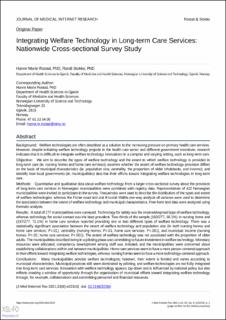| dc.description.abstract | Background:
Welfare technologies are often described as a solution to the increasing pressure on primary health care services. However, despite initiating welfare technology projects in the health care sector and different government incentives, research indicates that it is difficult to integrate welfare technology innovations in a complex and varying setting, such as long-term care.
Objective:
We aim to describe the types of welfare technology and the extent to which welfare technology is provided in long-term care (ie, nursing homes and home care services); examine whether the extent of welfare technology provision differs on the basis of municipal characteristics (ie, population size, centrality, the proportion of older inhabitants, and income); and identify how local governments (ie, municipalities) describe their efforts toward integrating welfare technologies in long-term care.
Methods:
Quantitative and qualitative data about welfare technology from a larger cross-sectional survey about the provision of long-term care services in Norwegian municipalities were combined with registry data. Representatives of 422 Norwegian municipalities were invited to participate in the survey. Frequencies were used to describe the distribution of the types and extent of welfare technologies, whereas the Fisher exact test and Kruskal-Wallis one-way analysis of variance were used to determine the association between the extent of welfare technology and municipal characteristics. Free-form text data were analyzed using thematic analysis.
Results:
A total of 277 municipalities were surveyed. Technology for safety was the most widespread type of welfare technology, whereas technology for social contact was the least prevalent. Two-thirds of the sample (183/277, 66.1%) in nursing home and (197/277, 71.1%) in home care services reported providing one or two different types of welfare technology. There was a statistically significant association between the extent of welfare technology and population size (in both nursing homes and home care services: P=.01), centrality (nursing homes: P=.01; home care services: P<.001), and municipal income (nursing homes: P=.02; home care services: P<.001). The extent of welfare technology was not associated with the proportion of older adults. The municipalities described being in a piloting phase and committing to future investment in welfare technology. Monetary resources were allocated, competency development among staff was initiated, and the municipalities were concerned about establishing collaborations within and between municipalities. Home care services seem to have a more person-centered approach in their efforts toward integrating welfare technologies, whereas nursing homes seem to have a more technology-centered approach.
Conclusions:
Many municipalities provide welfare technologies; however, their extent is limited and varies according to municipal characteristics. Municipal practices still seem dominated by piloting, and welfare technologies are not fully integrated into long-term care services. Innovation with welfare technology appears top-down and is influenced by national policy but also reflects creating a window of opportunity through the organization of municipal efforts toward integrating welfare technology through, for example, collaborations and committing personnel and financial resources. | en_US |

